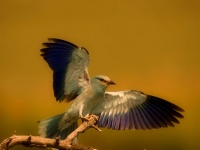More actions
Created page with "200px|thumb|right| A small, dazzlingly blue songbird native to the Shi'Al deserts, but also found in Kir and Xial. Typically 15 centimeters in..." |
mNo edit summary |
||
| Line 3: | Line 3: | ||
A small, dazzlingly blue songbird native to the [[Shi'Al]] deserts, but also found in [[Kir]] and [[Xial]]. | A small, dazzlingly blue songbird native to the [[Shi'Al]] deserts, but also found in [[Kir]] and [[Xial]]. | ||
Typically 15 centimeters in length, the lara prefers to build its nests in [[Chakh|chakh]] palms. Its song has a warbling quality and is most often heard during evening and early night, which has led to the | Typically 15 centimeters in length, the lara prefers to build its nests in [[Chakh|chakh]] palms. Its diet consist mostly of insects, but it also forages for seeds and larvae. Lara song has a warbling quality and is most often heard during evening and early night, which has led to the bird being referred to as "Vulcan Nightingale". | ||
Like the Terran bird, the lara's song is commonly associated with romance, or simply a sign that not only water and trees are nearby, but that the area is safe. The ancient Vulcan word Tee'vàh (modern Golic "tehvar" - danger) is thought to be an imitation of the lara's warning call, sounded at the approach of predators. | Like the Terran bird, the lara's song is commonly associated with romance, or simply a sign that not only water and trees are nearby, but that the area is safe. The ancient Vulcan word Tee'vàh (modern Golic "tehvar" - danger) is thought to be an imitation of the lara's warning call, sounded at the approach of predators. | ||
Latest revision as of 22:40, 14 November 2015

A small, dazzlingly blue songbird native to the Shi'Al deserts, but also found in Kir and Xial.
Typically 15 centimeters in length, the lara prefers to build its nests in chakh palms. Its diet consist mostly of insects, but it also forages for seeds and larvae. Lara song has a warbling quality and is most often heard during evening and early night, which has led to the bird being referred to as "Vulcan Nightingale".
Like the Terran bird, the lara's song is commonly associated with romance, or simply a sign that not only water and trees are nearby, but that the area is safe. The ancient Vulcan word Tee'vàh (modern Golic "tehvar" - danger) is thought to be an imitation of the lara's warning call, sounded at the approach of predators.
The lara is one of the favorite motifs of Vulcan poetry, song and myths.
